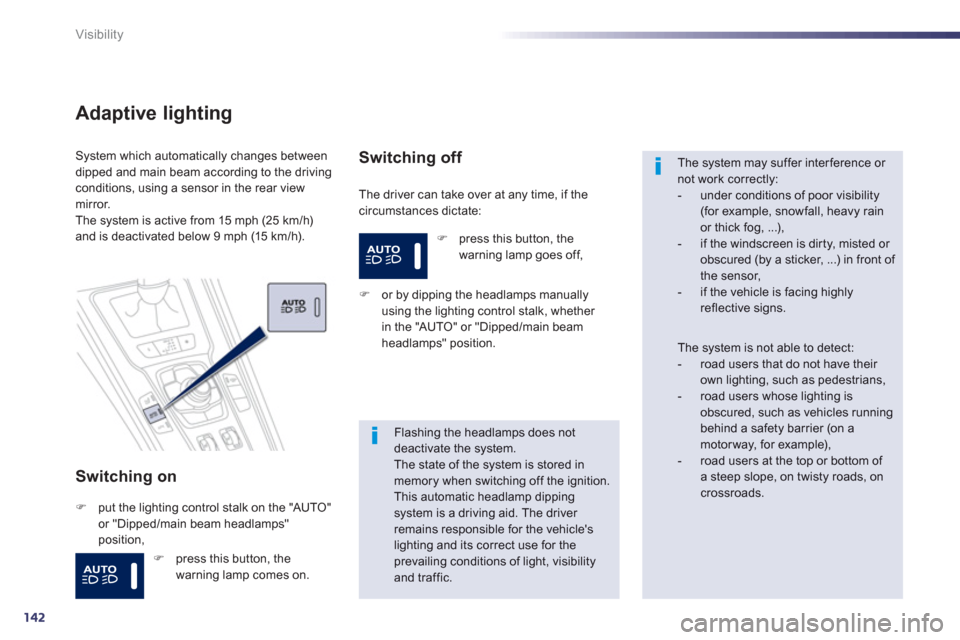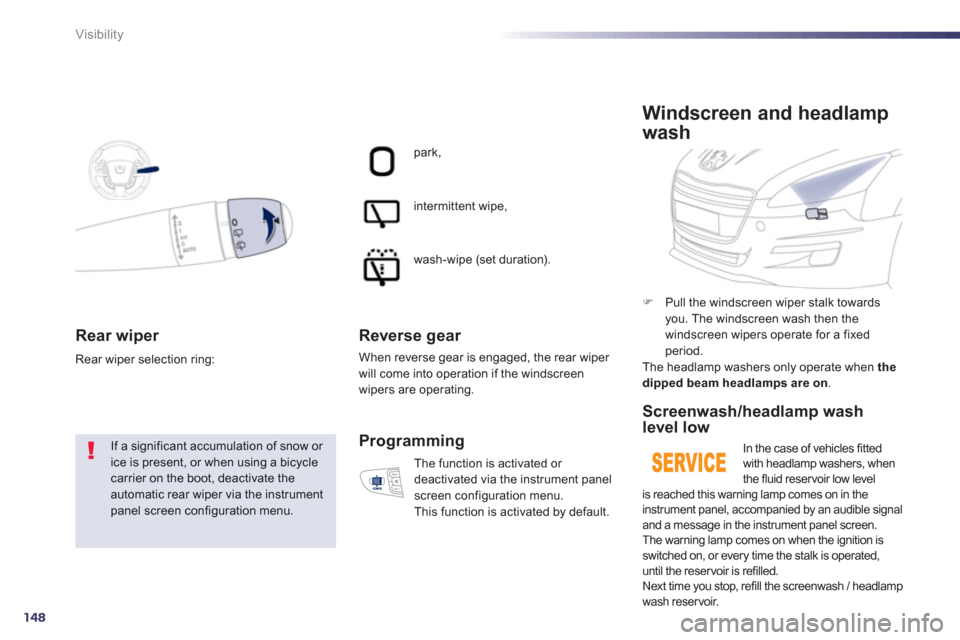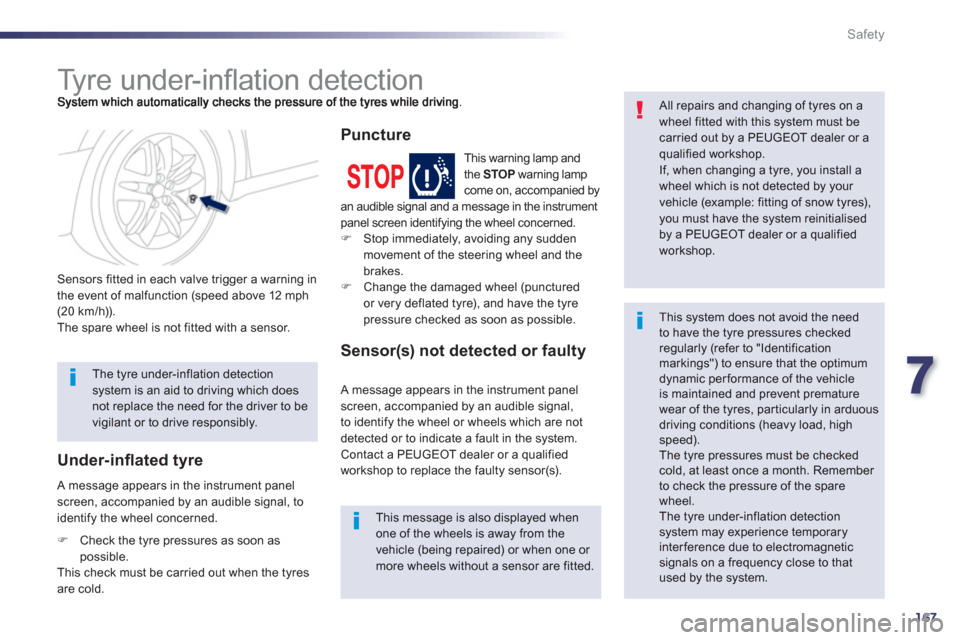Page 144 of 340

142
Visibility
Adaptive lighting
Switching on
The driver can take over at any time, if thecircumstances dictate:
System which automatically changes betweendipped and main beam according to the driving conditions, using a sensor in the rear view mirror.
The system is active from 15 mph (25 km/h) and is deactivated below 9 mph (15 km / h).
Fput the lighting control stalk on the "AUTO"
or "Dipped/main beam headlamps"
position,
Switching off
F
or by dipping the headlamps manually using the lighting control stalk, whether
in the "AUTO" or "Dipped/main beam
headlamps" position.
Flashing the headlamps does notdeactivate the system.The state of the system is stored in memory when switching off the ignition. This automatic headlamp dipping system is a driving aid. The driver remains responsible for the vehicle'slighting and its correct use for theprevailing conditions of light, visibility and traffic.
The system may suffer interference or not work correctly:
- under conditions of poor visibility(for example, snowfall, heavy rain or thick fog, ...),
- if the windscreen is dir ty, misted or obscured (by a sticker, ...) in front of the sensor,
- if the vehicle is facing highly reflective signs.
The system is not able to detect:
- road users that do not have their own lighting, such as pedestrians,
- road users whose lighting isobscured, such as vehicles running behind a safety barrier (on amotorway, for example),
- road users at the top or bottom of a steep slope, on twisty roads, oncrossroads.
Fpress this button, the
warning lamp goes off,
F press this button, the
warning lamp comes on.
Page 146 of 340
144
Visibility
Manual adjustment
of halogen
headlamps
Automatic adjustment of xenon
headlamps
To avoid causing a nuisance to other road
users, the beams of the halogen headlamps should be adjusted according to the load in the
vehicle.1 Driver 2
Driver + front passenger.3
Driver + front passenger + rear passengers.4
5 people.5
5 people + a load in the boot. 6
Driver + a load in the boot. If a fault occurs
, this warning lamp is displayedin the instrument panel,
accompanied by an audible signal and a
message in the instrument panel screen.
The s
ystem then places your headlamps in the lowest position.
In order to avoid causing a nuisance to other road users, this system corrects the height of the
xenon headlamps beam automatically and when
stationary, in relation to the load in the vehicle.
If a fault occurs, do not touch the xenonbulbs. Contact a PEUGEOT dealer or a qualified workshop.
The initial setting is position "0".
Page 147 of 340
5
145
Visibility
When the dipped or main beam headlamps
are on, this function enables the light beams toprovide improved lighting of the side of the road
when cornering.
The use of this function, associated with the
xenon headlamps only, considerably improves
the quality of your lighting when cornering.
Main directional lighting
with directional lighting
without directional lighting
Programming
Operating fault
The function is activated or
deactivated via the configuration
menu (in the instrument panel
screen).
When stationary or moving at very lowspeed or when reverse gear is engaged,the function is inactive.
The status of the function remains in the memory when the ignition is switched off. I
f a fault occurs, this warning lamp flashes in the instrument panel,
accompanied by a message in the
instrument panel screen.
Contact a PEUGEOT dealer or a qualified workshop.
Page 150 of 340

148
Visibility
Rear wiper
If a significant accumulation of snow or ice is present, or when using a bicyclecarrier on the boot, deactivate theautomatic rear wiper via the instrument panel screen configuration menu. Rear wiper selection rin
g:
park,
intermittent wipe,
wash-wipe
(set duration).
Reverse gear
When reverse gear is engaged, the rear wiper
will come into operation if the windscreen
wipers are operating.
Th
e function is activated or
deactivated via the instrument panel
screen confi
guration menu.
This function is activated by default.
Programming
F
Pull the windscreen wiper stalk towards you. The windscreen wash then the
windscreen wipers operate for a fixed period.
The headlamp washers only operate when the
dipped beam headlamps are on .
Windscreen and headlamp
wash
Screenwash/headlamp washlevel low
In the case of vehicles fittedwith headlamp washers, when
the fluid reservoir low level
is reached this warning lamp comes on in the
instrument panel, accompanied b
y an audible signaland a message in the instrument panel screen.
The warning lamp comes on when the ignition isswitched on, or every time the stalk is operated,until the reservoir is refilled.
Next time you stop, refill the screenwash / headlamp
wash reservoir.
Page 151 of 340
5
149
Visibility
Automatic rain sensitive
windscreen wi
pers
The windscreen wipers operate automatically,
without an
y action on the par t of the driver, if
rain is detected (sensor behind the rear view mirror), adapting their speed to the intensity of
the rainfall.
Switching on
Briefly push the control stalkdownwards.
This warning lamp comes on in the
instrument panel and a message is
displayed.Brie
fly push the control stalk
downwards again, or place thecontrol stalk in another position (Int,
1 or 2).
This warning lamp goes off in the instrument
panel and a message is displayed.
Switching off
The automatic rain sensitive windscreenwipers must be reactivated by pushing the control stalk downwards, if theignition has been off for more than one minute.
Page 167 of 340
7
165
Safety
Direction indicators
F
Lower the lighting control stalk fully when moving to the left. F
Raise the lighting control stalk fully when moving to the right.
"Motorway" function
Move the stalk briefly upwards or downwards,
without going beyond the point of resistance;
the corresponding direction indicators will flash 3 times.
If you forget to cancel the direction indicators for more than twenty seconds, the volume of the audible signal will increase if the speed is above40 mph (60 km/h).
Hazard warning lamps
Press the button, the direction indicators flash.
They can operate with the ignition off.
Automatic operation of
hazard warnin
g lamps
When braking in an emergency, depending on
the rate of deceleration, as well as when the ABS regulation is invoked or in the event of animpact, the hazard warning lamps come on
automatically.
They switch off automatically the first time you accelerate.F
You can also switch them off by pressingthe button.
Page 168 of 340
166
Safety
Horn
F
Press the central part of the multifunction steering wheel.
Audible warning system to alert other road
users to an imminent dan
ger.
Use the horn moderately and only in the following circumstances:
- immediate danger,
- approaching a location lackingvisibility.
Emergency or
assistance call
This system allows you to make an emergencyor assistance call to the emergency services or
to the dedicated PEUGEOT ser vice.
For more information on the use of this function, refer to the "Audio andtelematics" section.
Page 169 of 340

7
167
Safety
Ty r e u n d e r - i nfl ation detection
Sensors fitted in each valve trigger a warning in
the event of malfunction (speed above 12 mph (20 km/h)).
The spare wheel is not fitted with a sensor.
All repairs and changing of tyres on awheel fitted with this system must becarried out by a PEUGEOT dealer or a qualified workshop.
If, when changing a tyre, you install awheel which is not detected by your vehicle (example: fitting of snow tyres), you must have the system reinitialised
by a PEUGEOT dealer or a qualifiedworkshop.
This message is also displayed whenone of the wheels is away from thevehicle (being repaired) or when one or more wheels without a sensor are fitted.
The tyre under-inflation detectionsystem is an aid to driving which doesnot replace the need for the driver to bevigilant or to drive responsibly.
This system does not avoid the needto have the tyre pressures checkedregularly (refer to "Identification markings") to ensure that the optimumdynamic performance of the vehicleis maintained and prevent premature wear of the tyres, particularly in arduousdriving conditions (heavy load, highspeed). The tyre pressures must be checked cold, at least once a month. Remember to check the pressure of the spare wheel.
The tyre under-inflation detection system may experience temporary interference due to electromagnetic signals on a frequency close to that used by the system.
A message appears in the instrument panelscreen, accompanied by an audible signal, to
identify the wheel concerned.
Under-infl ated tyre
This warning lamp and
the STOPwarning lamp come on, accompanied by an audible signal and a message in the instrument panel screen identifying the wheel concerned. FStop immediately, avoiding any sudden
movement of the steering wheel and thebrakes.
FChange the damaged wheel (punctured
or very deflated tyre), and have the tyre
pressure checked as soon as possible.
Puncture
A message appears in the instrument panel
screen, accompanied by an audible signal,
to identify the wheel or wheels which are not
detected or to indicate a fault in the system.Contact a PEUGEOT dealer or a qualifiedworkshop to replace the faulty sensor(s).
Sensor(s) not detected or faulty
F
Check the tyre pressures as soon aspossible.
This check must be carried out when the tyres
are cold.